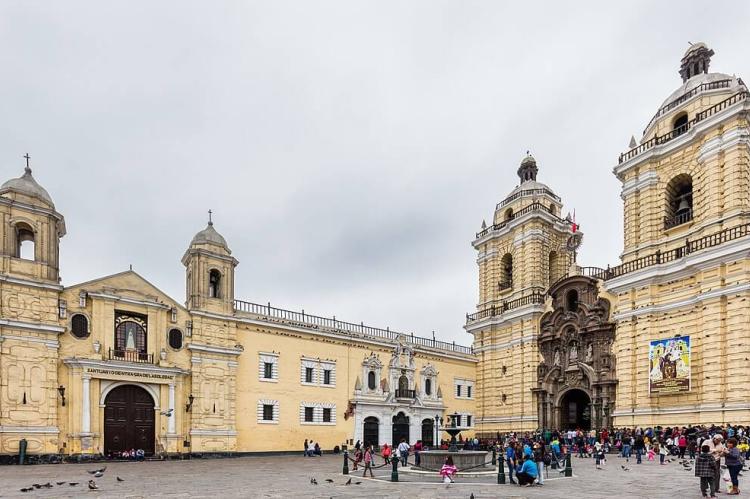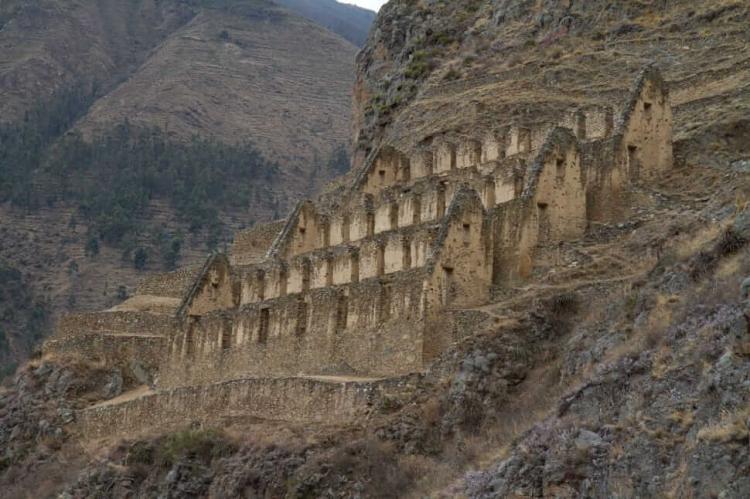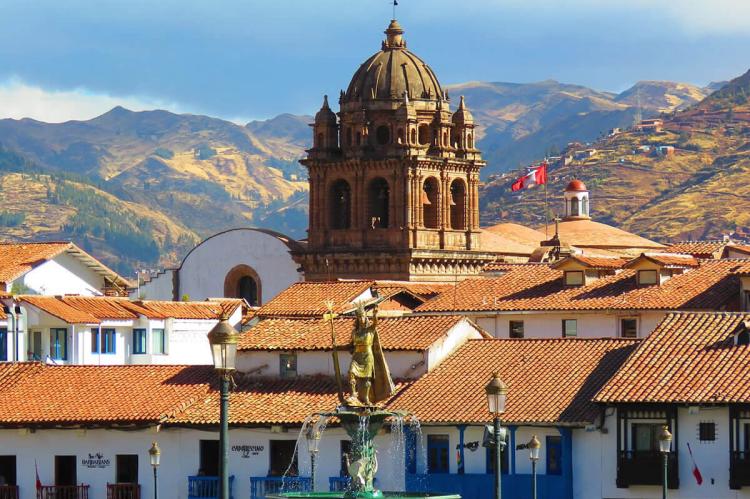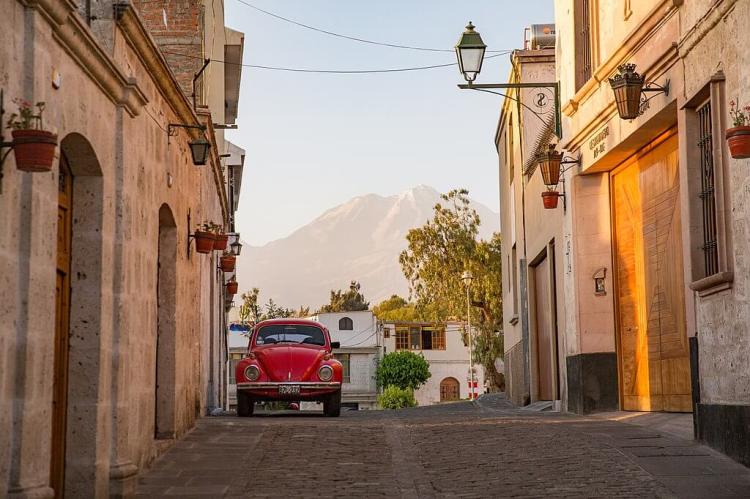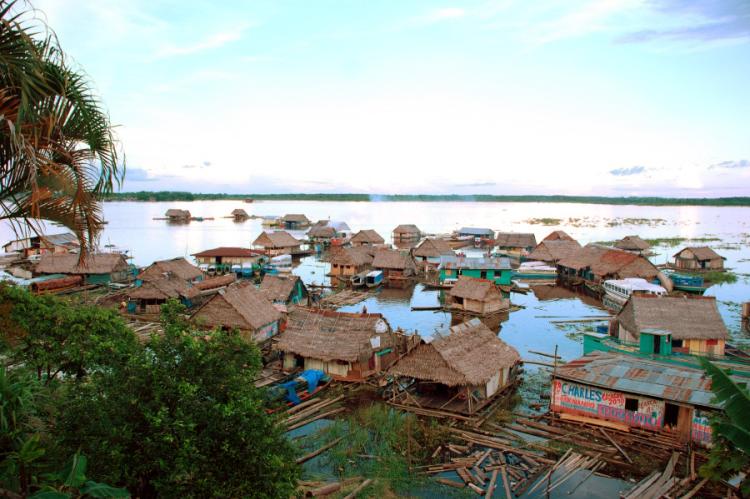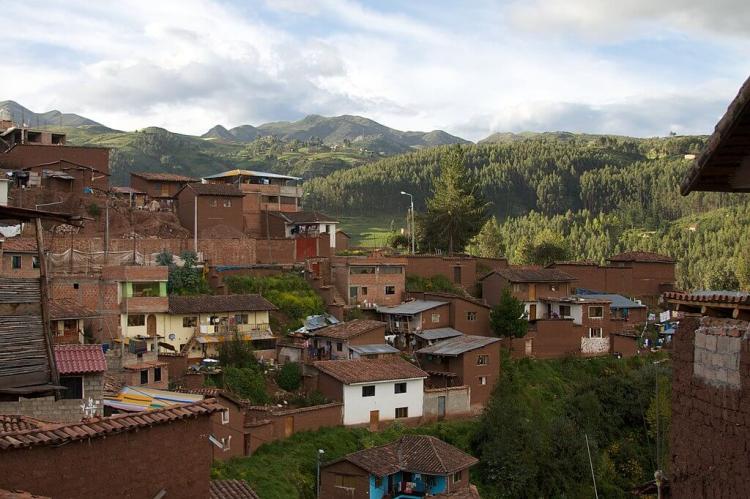Peru: Cultural Landscape
Peru's cultural landscape is a medley of ancient civilizations, colonial history, indigenous traditions, contemporary arts, and culinary excellence. The preservation and celebration of its rich heritage and ongoing cultural expressions make Peru a captivating destination for cultural exploration.
The Cultural Landscape of Peru
Peru's cultural heritage is a complex tapestry woven from ancient civilizations, colonial influences, diverse Indigenous traditions, and contemporary expressions. The country's cultural landscape reflects centuries of history and a vibrant mix of Indigenous and European influences, enhanced by its renowned culinary scene, music, and thriving arts community.
Ancient Indigenous Civilizations: Foundations of Peruvian Culture
Peru is home to some of the world's most sophisticated ancient civilizations, whose influence resonates in the country's culture and identity. The Moche, Nazca, Chavín, and Inca civilizations left remarkable architectural and artistic legacies, including ancient ruins, complex irrigation systems, and intricate art forms.
Architectural Marvels of the Inca Empire
The Inca Empire, Peru's most powerful pre-Columbian civilization in Peru, is best known for its awe-inspiring stone constructions and agricultural terraces. Machu Picchu, a UNESCO World Heritage Site, is the most famous Incan ruin, attracting visitors with its remarkable stonework and mountaintop setting. Sacsayhuamán, near Cusco, is another stunning example of Inca engineering, with precisely cut stones fitted so tightly that no mortar was required. The remnants of the empire's vast road network and intricate agricultural terraces in the Sacred Valley highlight the Inca's technical expertise and deep connection to the land.
The Legacy of the Nazca and Moche Cultures
The Nazca civilization left behind one of Peru's most mysterious cultural artifacts: the Nazca Lines, massive geoglyphs etched into the desert that form shapes of animals and geometric designs. The purpose of these lines remains a topic of debate, but they reveal the Nazca's advanced understanding of astronomy and environmental adaptation. The Moche culture, concentrated in the northern coastal region, is known for its extraordinary pottery and monumental adobe pyramids, such as the Huaca del Sol and Huaca de la Luna. These cultures exemplify Peru's early civilizations' advanced architectural and artistic capabilities.
Spanish Colonial Legacy: A Fusion of Cultures
The Spanish colonization of Peru impacted the country's architecture, language, and religion. Spanish colonial architecture is particularly prominent in cities such as Lima, Arequipa, and Trujillo, where the fusion of European and Indigenous styles is visible in ornate churches, grand plazas, and colorful facades.
Lima: The City of Kings
Lima, known as the "City of Kings," was established as the capital of the Spanish Empire in South America and became an epicenter of Spanish influence. The city's historic center, a UNESCO World Heritage Site, showcases baroque architecture, including iconic structures like the Basilica and Convent of San Francisco and the Government Palace. The city's colonial charm reflects Peru's multicultural history, blending Indigenous and Spanish traditions in architectural and urban design.
Arequipa and Trujillo: Cities of Colonial Grandeur
In Arequipa, "The White City," Spanish colonial architecture incorporates the unique sillar stone, giving the buildings a distinctive white appearance. Trujillo, another historic city, features well-preserved colonial mansions and religious structures that highlight Spanish influence on Peruvian urban aesthetics. These cities are lasting reminders of the country's colonial era, when European art and architecture merged with Andean traditions.
Indigenous Cultures: Living Traditions of the Andes and Amazon
Peru's Indigenous communities, notably the Quechua and Aymara people, maintain deeply rooted traditions that connect modern Peru to its ancient past. Indigenous practices are visible in art, language, music, and festivals, preserving cultural heritage despite the challenges of globalization and modernization.
Traditional Crafts and Artistic Expressions
Indigenous communities are renowned for their textiles, pottery, and other crafts, each with unique patterns and techniques passed down through generations. Peruvian textiles, woven with alpaca and sheep wool, are intricately designed and often dyed with natural pigments. These textiles are not only decorative but also serve cultural and ritual purposes. Pottery, particularly from regions like Cusco and Ayacucho, also showcases the creative skill of Indigenous artisans, who incorporate ancient symbols and motifs representing the natural and spiritual world.
Festivals and Rituals
Peruvian festivals are vibrant expressions of Indigenous culture, blending pre-Columbian and Catholic traditions. Festivals like Inti Raymi, the Festival of the Sun, pay homage to the Inca god Inti with music, colorful costumes, and traditional dances. Similarly, the Qoyllur Rit'i festival, held in the Andes, brings thousands of Indigenous people together for an annual pilgrimage combining Catholic and native beliefs, underscoring the syncretic nature of Peruvian culture.
Culinary Excellence: A Fusion of Flavors
Peruvian cuisine has gained international acclaim for its blend of Indigenous, Spanish, African, and Asian influences. It uses diverse ingredients like potatoes, quinoa, aji peppers, and fresh seafood, and its culinary offerings are celebrated for their variety and bold flavors.
Signature Dishes and Culinary Innovations
Classic Peruvian dishes such as ceviche, marinated fish prepared with lime and chili peppers, and lomo saltado, a stir-fried beef dish with Chinese influences, showcase Peru's culinary ingenuity. Causa, a layered dish made with seasoned mashed potatoes, and anticuchos, skewered and grilled meat, are also local favorites. Lima, a hub of culinary creativity, is home to internationally acclaimed restaurants that have made the city a world-class gastronomic destination.
Contemporary Arts: Bridging Tradition and Modernity
Peru's art scene is a vibrant blend of traditional and contemporary expressions. Modern Peruvian artists draw inspiration from Indigenous themes and techniques, incorporating them into contemporary mediums such as painting, sculpture, and installations. Lima's art galleries and museums, such as the Museum of Contemporary Art and the Lima Art Museum, promote local and international talent and showcase the country's dynamic artistic landscape.
Music and Dance: The Rhythms of Peru
Music and dance are integral to Peruvian culture, with genres ranging from Andean folk music to Afro-Peruvian rhythms. Traditional Andean music features instruments like the quena (flute) and the charango (a small stringed instrument), while Afro-Peruvian music centers around the cajón, a percussion instrument. Traditional dances like the marinera, huayno, and diablada are performed during festivals, illustrating Peru's cultural diversity and connection to its history.
Contemporary Influences on Peruvian Culture
Globalization, technology, immigration, and tourism have introduced new elements to Peruvian culture, blending modernity with tradition.
Globalization and Technology
As Peru becomes increasingly integrated into the global economy, its exposure to international fashion, technology, and media trends has grown. The internet and social media have created platforms where Peruvians can engage with the world and share their culture globally. Digital tools allow artisans and artists to preserve and promote traditional crafts, broadening their reach and securing economic opportunities.
Tourism and Cultural Exchange
Tourism has transformed Peru into a cultural destination, particularly for visitors eager to experience the country's archaeological sites and festivals. While tourism has introduced new ideas and customs to Peru, it has also raised awareness of traditional Peruvian culture on the world stage. Many local communities benefit economically from tourism, though balancing tourism with cultural preservation remains an ongoing challenge.
Immigration: A Diverse Cultural Mix
Peru has a history of immigration, with waves of Chinese, Japanese, African, and European immigrants contributing to the country's cultural diversity. These communities have introduced new culinary flavors, religious beliefs, and artistic expressions, enhancing modern Peru's rich cultural mosaic.
Challenges Facing Peruvian Culture
Peru faces significant challenges as it seeks to preserve its cultural heritage while embracing modernization and global interconnectedness.
Economic Inequality and Poverty
Poverty, particularly in rural regions, remains a barrier to cultural preservation as communities struggle to maintain traditions while striving for economic improvement. Indigenous and rural communities are disproportionately affected, and economic constraints can limit access to education, healthcare, and opportunities for cultural expression.
The Impact of Globalization
While globalization has introduced new ideas, it also poses risks to traditional practices. There is concern that the influx of global cultural influences may dilute Peru's unique cultural identity, as modern media and consumerism overshadow local customs and values.
Tourism's Double-Edged Sword
Tourism presents both an opportunity and a challenge. While it promotes cultural awareness and brings economic benefits, it can also lead to the commercialization and alteration of traditional customs. In some cases, tourism impacts natural and archaeological sites, creating tensions between preservation and development.
Political Instability and Cultural Protection
Political instability has historically affected Peru's ability to implement consistent cultural preservation policies. Political challenges can limit the government's capacity to promote Indigenous rights, protect cultural sites, and support sustainable development, which is vital for preserving Peru's cultural heritage.
Conclusion: Peru's Enduring Cultural Legacy
Peru's cultural landscape is a rich, dynamic blend of ancient traditions and modern influences. From the heritage of the Incas to the Spanish colonial legacy, diverse Indigenous communities, and vibrant contemporary art scene, Peru's culture reflects a resilience and adaptability that continue to define its identity. As Peru navigates the complexities of globalization, tourism, and economic development, efforts to protect and celebrate its cultural heritage are essential to preserving the nation's rich traditions and sharing them with the world. Through these ongoing efforts, Peru remains deeply connected to its past while embracing the future.
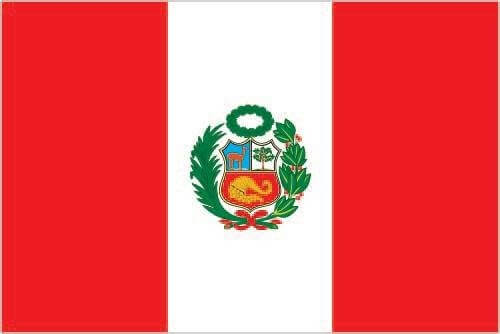
The official flag of Peru.
Cultural Geography of Peru
Largest Cities / Metro Areas
Ranked by population estimate (2023):
Lima (10,143,000): Lima, the capital of Peru, is a large and sprawling city on the central coast. It is the second-largest city in South America after São Paulo, Brazil. Lima is a significant economic and cultural center, home to various industries, including manufacturing, tourism, and agriculture. It is also home to many universities and other educational institutions. Lima is a popular tourist destination, known for its colonial architecture, museums, and delicious food.
Arequipa (1,113,000): Arequipa, located in the south of Peru, is known for its colonial architecture, its white volcanic rock, and its delicious food. Founded in 1540 by the Spanish conquistadors, it quickly became an important center for trade and commerce. The city was built with sillar, a white volcanic rock found in the region. Very strong and durable, sillar has helped to preserve Arequipa's colonial architecture. Arequipa is home to important historical and cultural landmarks, including the Cathedral of Arequipa and the Santa Catalina Monastery.
Trujillo (962,000): Trujillo is a city in northwestern Peru, located on the coast of the Pacific Ocean. It is the capital of the La Libertad Region. Trujillo is known for its colonial architecture, archaeological sites, and vibrant culture. Founded by the Spanish in 1534, it quickly became an important center for trade and commerce. The city was built on the ruins of the Moche and Chimú civilizations, and it is home to several important archaeological sites, including the Chan Chan ruins, the Huaca de la Luna, and the Huaca del Sol. Trujillo is also home to some critical colonial-era buildings, including the Cathedral of Trujillo, the Church of San Francisco, and the Government Palace. The city is also home to several museums, including the Rafael Larco Herrera Museum, the Museum of the Nation, and the Regional Museum of Trujillo.
Chiclayo (759,000): Chiclayo is a city in northwestern Peru, located on the coast of the Pacific Ocean. It is the capital of the Lambayeque Region. Chiclayo is known for its colonial architecture, archaeological sites, and vibrant culture. It was founded by the Spanish in 1535 and quickly became an important center for trade and commerce. The city was built on the ruins of the Moche civilization, and it is home to several important archaeological sites, including the Huaca del Sol y la Luna, the Sipán tomb, and the Túcume ruins. Chiclayo is also home to critical colonial-era buildings, including the Cathedral of Chiclayo, the Church of San Francisco, and the Government Palace.
Piura (737,000): Piura is a city in northwestern Peru, located on the Piura River in the Sechura Desert. It is the capital of the Piura Region. In 1532, Spanish Conqueror Francisco Pizarro founded San Miguel de Piura, the third Spanish city in South America and the first in Peru. Piura declared its independence from Spain on 4 January 1821. Piura is a major agricultural and commercial center, home to several industries, including tourism, manufacturing, and fishing.
Cusco (684,000): Cusco is a city in southeastern Peru, near the Urubamba Valley of the Andes mountain range. It is the capital of the Cusco Region and the Cusco Province. Its elevation is around 3,400 m (11,200 ft). Cusco was the capital of the Inca Empire from the 13th century until the 16th-century Spanish conquest. In 1983, UNESCO declared Cusco a World Heritage Site. It has become a significant tourist destination, hosting nearly 2 million visitors annually.
Huancayo (645,000): Huancayo is a city in the Central Andes of Peru, in the Junín Region. It is the capital of the Huancayo Province. The Spanish founded Huancayo in 1572. It quickly became an important regional commercial center, and its population increased. The city was home to several important events during the Peruvian War of Independence, including the Battle of Junín in 1824. Today, Huancayo is a thriving city and a significant commerce, education, and cultural center.
Iquitos (473,000): Iquitos is a city in the northeastern Peruvian Amazon, east of the Andes. It is the largest metropolis in the Peruvian Amazon and the ninth-most populous city in Peru. Iquitos is the largest city in the world, and it cannot be reached by road or on an island; it is only accessible by river and air. Iquitos was founded in 1757 as a Jesuit mission. It increased during the rubber boom of the late 19th century. After the rubber boom collapsed in the early 20th century, Iquitos declined. However, it has since rebounded and is now a thriving city with a diverse economy, including tourism, agriculture, and oil extraction.
Pucallpa (450,000): Pucallpa is a city in the Ucayali Region of Peru on the Ucayali River. It is the capital of the Ucayali Region and the largest city in the Amazon Rainforest. Pucallpa was founded in 1845 by Franciscan missionaries. The town increased in the late 19th and early 20th centuries due to the rubber boom. In the 1950s, Pucallpa became a significant center for the timber industry. Pucallpa is a popular tourist destination for its rainforest setting and proximity to several natural attractions, including Yarinacocha Lake, Otorongo Cocha Lake, Manú National Park, and the Pacaya Samiria National Reserve.
Tacna (377,000): Tacna is a city in southern Peru, located on the border with Chile. It is the capital of the Tacna Region and the tenth most populous city in Peru. Tacna was founded by the Spanish in 1535. The town quickly became an important center for trade and commerce. In the 18th century, Tacna became a significant center for the silver trade. In the 19th century, Tacna was a center for the Peruvian War of Independence. Tacna is a popular tourist destination with several historical and cultural landmarks.
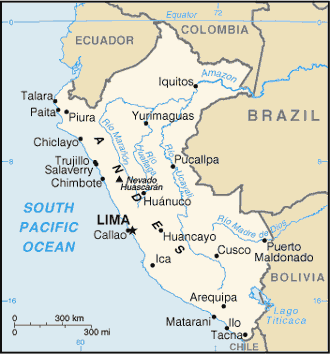
CIA map of Peru.
Administrative Divisions
Peru has been divided administratively into 25 regions (formerly known as departments) subdivided into provinces, except for the Lima Province, which does not belong to a region. The provinces, which total 196, are further subdivided into districts. Lima Province, which contains the city of Lima, the country's capital, is autonomous and not under the jurisdiction of the Regional Government.
Regions
Following is a list of regions along with capital cities in parentheses and a brief description:
Amazonas (Chachapoyas): Located in the northern part of Peru, Amazonas is known for its lush landscapes, including cloud forests, waterfalls, and archaeological sites such as the Kuelap Fortress.
Ancash (Huaraz): Ancash is home to the stunning Cordillera Blanca mountain range, which offers trekking and mountaineering opportunities. It also has beautiful lakes, like Lake Llanganuco.
Apurímac (Abancay): Apurímac is known for its rugged terrain, deep canyons, and archaeological sites, such as the Andahuaylas Fortress.
Arequipa (Arequipa): This city is famous for its well-preserved colonial architecture, including the Santa Catalina Monastery. It is also the gateway to Colca Canyon, one of the world's deepest canyons.
Ayacucho (Ayacucho): Ayacucho is rich in history and culture and is known for its colonial architecture and archaeological sites, such as Wari and Vilcashuamán.
Cajamarca (Cajamarca): This region is famous for its role in the history of the Inca Empire and the capture of Atahualpa. It has hot springs and archaeological sites.
Callao (Callao): Callao is Peru's primary port and part of the Lima Metropolitan Area, which is known for its maritime activities.
Cusco (Cusco): Cusco is the heart of the Inca Empire and boasts numerous archaeological sites, including Machu Picchu. It's a central hub for tourism in Peru.
Huancavelica (Huancavelica): Huancavelica is known for its high-altitude terrain and mining heritage. It's also a center for traditional Andean culture.
Huánuco (Huánuco): Huánuco offers a mix of the Amazon rainforest and Andean highlands, making it a diverse region with eco-tourism opportunities.
Ica (Ica): Ica is known for its vast desert landscapes, including the Huacachina Oasis. It's also a wine-producing region.
Junín (Huancayo): Junín is known for its high-altitude lakes, including Lake Junín. It offers outdoor activities like trekking and birdwatching.
La Libertad (Trujillo): La Libertad is known for its pre-Inca and Moche archaeological sites, including the Temple of the Sun and the Chan Chan ruins.
Lambayeque (Chiclayo): Lambayeque is famous for its archaeological treasures, including the Lord of Sipán tomb, and its cuisine.
Lima (Huacho): The Lima Region, located in the central coastal area of Peru, encompasses both the city of Lima and its surrounding provinces, including significant agricultural and urban areas.
Loreto (Iquitos): Loreto is located in the Peruvian Amazon and is known for its lush rainforests, rivers, and wildlife.
Madre de Dios (Puerto Maldonado): Madre de Dios is another Amazonian region known for its biodiversity and eco-tourism, particularly in the Tambopata and Manú reserves.
Moquegua (Moquegua): Moquegua is known for its desert landscapes, historic churches, and mining activities.
Pasco (Cerro de Pasco): Pasco is a high-altitude region with mining as a significant industry. The area has beautiful lakes and natural beauty.
Piura (Piura): Piura is known for its beaches along the northern coast and traditional cuisine.
Puno (Puno): Puno is located on the shores of Lake Titicaca and is known for its Indigenous culture and traditional festivals.
San Martín (Moyobamba): San Martín is known for its diverse landscapes, including rainforests and waterfalls, and its coffee production.
Tacna (Tacna): This town in southern Peru is known for its history, including the Battle of Tacna. It also has hot springs.
Tumbes (Tumbes): Tumbes is known for its beautiful beaches and mangrove forests along Peru's northern coast.
Ucayali (Pucallpa): Ucayali is in the Amazon rainforest and is known for its rivers, biodiversity, and Indigenous communities.
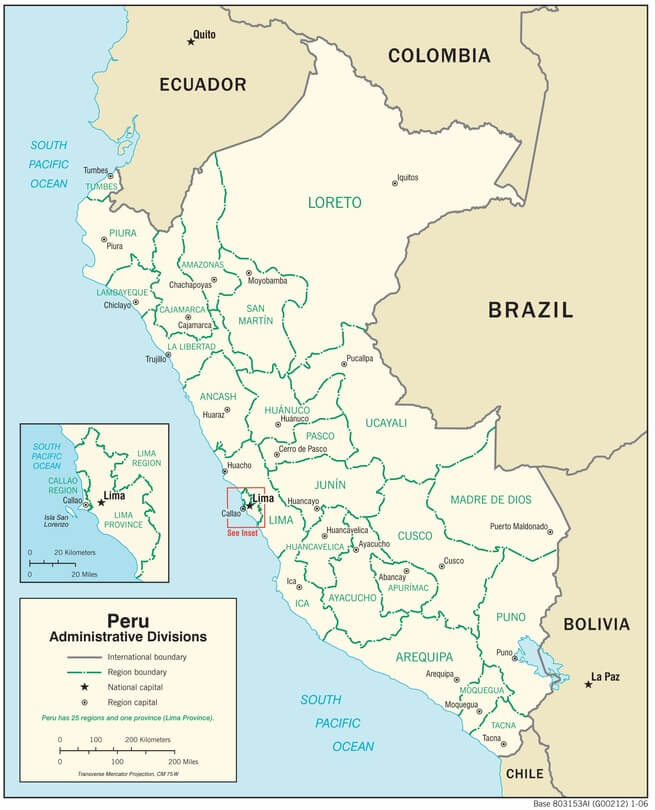
Peru administrative map.
Geographic Regions (Zones)
Peru is traditionally described as three broad longitudinal regions. Each region comprises a different topography and sharply contrasting environment, thus forming the country's major terrestrial regions.
La Costa: the arid Costa, or coastal region, in the west
La Sierra: the rugged Sierra, or the Peruvian Andes, in the middle
La Selva: the wet and forested Amazonia, or jungle region, in the east
Three broad climatic regions can be readily distinguished, paralleling the three main geographic regions: coastal desert, mountain highland, and tropical forest.
See more: Natural Landscape of Peru
Historical, Cultural, and Natural Landmarks
Peru has a rich mixture of historical, cultural, and natural landmarks. Here are some notable examples, separated by geographic region or zone.
La Costa
The La Costa region of Peru, also known as the Coastal region, is home to several attractions, landmarks, and protected areas offering diverse experiences, from exploring ancient archaeological sites to enjoying coastal landscapes and engaging in adventure activities.
Lima: Peru's capital city, Lima, is a vibrant metropolis with a rich historical and cultural heritage. Its historic center, the Plaza de Armas, and the upscale district of Miraflores offer a blend of colonial and modern architecture. Lima is renowned for its culinary scene, archaeological museums, and lively nightlife.
Nazca Lines: Located in the Nazca Desert, the Nazca Lines are a series of geoglyphs etched into the desert floor. These enormous designs depict various shapes, including animals, plants, and geometric patterns, and are best viewed from the air. They remain one of Peru's most mysterious and intriguing archaeological sites.
Paracas National Reserve: This protected area encompasses the Paracas Peninsula and the surrounding waters of the Pacific Ocean. It is renowned for its diverse marine wildlife, including sea lions, dolphins, and seabirds. Visitors can explore the reserve's rugged coastline, take boat tours to nearby islands, and observe the region's rich biodiversity.
Huacachina: Located near the city of Ica, Huacachina is a desert oasis surrounded by towering dunes. It is a popular destination for adventure enthusiasts who enjoy sandboarding and dune-buggying. Visitors can relax by the oasis and witness breathtaking sunsets over the desert landscape.
Trujillo: Trujillo is a colonial city on the northern coast of Peru known for its well-preserved Spanish architecture. The city's main attractions include the Plaza de Armas, the Cathedral, and the Chan Chan Archaeological Zone, once the capital of the ancient Chimú civilization.
Caral-Supe Archaeological Site: Considered one of the oldest cities in the Americas, the Caral-Supe Archaeological Site is a UNESCO World Heritage site. It showcases the remains of the ancient Caral civilization, which thrived around 5,000 years ago. The site includes impressive pyramids, plazas, and ceremonial structures.
Sechura Desert: The Sechura Desert is a vast desert region in northern Peru. It features unique landscapes, including dunes, desert lagoons, and dry riverbeds. The area is ideal for sandboarding, off-roading, and exploring the unique flora and fauna adapted to desert conditions.
El Ñuro: Located on the northern coast, El Ñuro is known for encountering giant sea turtles. Visitors can swim and snorkel with these gentle creatures in their natural habitat, creating unforgettable experiences.
La Sierra
The La Sierra region of Peru, also known as the Highland region, is known for its stunning mountain landscapes, historical sites, and cultural heritage. These attractions, landmarks, and protected areas showcase the country's rich history, natural beauty, and cultural heritage.
Cusco: Cusco is a historic city and the gateway to Machu Picchu. It was the capital of the Inca Empire and was filled with well-preserved Inca ruins and Spanish colonial architecture. The main square, Plaza de Armas, the Cathedral, and the Qorikancha Temple are must-visit sites in Cusco.
Machu Picchu: This UNESCO World Heritage site is an iconic Inca citadel perched on a mountain ridge. Known as the "Lost City of the Incas," Machu Picchu offers breathtaking views, intricate stone structures, and a sense of ancient wonder. It is one of the most famous archaeological sites in the world.
Sacred Valley: Located near Cusco, the Sacred Valley is a picturesque region dotted with ancient Inca ruins, traditional Andean villages, and stunning landscapes. Highlights include the Pisac Ruins, Ollantaytambo Fortress, and the traditional market in Pisac.
Huaraz and the Cordillera Blanca: Huaraz is a city nestled in the stunning Cordillera Blanca mountain range. It is a base for outdoor enthusiasts who want to explore the region's impressive snow-capped peaks, glacial lakes, and hiking trails. The Laguna 69 and Huascarán National Park are popular destinations in this area.
Arequipa: Known as the "White City," Arequipa is famous for its colonial architecture, constructed from white volcanic stone. The historic city center, a UNESCO World Heritage site, features the impressive Santa Catalina Monastery, the Plaza de Armas, and the picturesque Yanahuara neighborhood.
Colca Canyon: One of the world's deepest canyons, the Colca Canyon offers breathtaking natural beauty and the opportunity to spot Andean condors. Visitors can enjoy hiking, hot springs, and traditional Andean villages that showcase the region's cultural heritage.
Choquequirao: Often referred to as the "sister city" of Machu Picchu, Choquequirao is an archaeological site hidden in the mountains. It offers a similar experience to Machu Picchu but with fewer crowds, making it an appealing destination for adventurous travelers.
Manú National Park: Located on the eastern slopes of the Peruvian Andes, Manú National Park is a UNESCO World Heritage site and one of the most biodiverse areas in the world. It is home to many plant and animal species, including jaguars, giant river otters, and hundreds of bird species.
La Selva
The La Selva region of Peru, part of the Amazon Rainforest, is a biodiverse area teeming with wildlife, lush vegetation, and unique ecosystems. These attractions, landmarks, and protected areas allow visitors to immerse themselves in the region's incredible biodiversity and cultural richness.
Iquitos: Iquitos is the largest city in the Peruvian Amazon and is a popular starting point for exploring the region. It offers a blend of urban amenities and access to the surrounding rainforest. Visitors can explore the bustling Belén Market, visit historical sites, and enjoy the vibrant riverfront atmosphere.
Pacaya-Samiria National Reserve: One of the largest protected areas in Peru, the Pacaya-Samiria National Reserve is a pristine wilderness characterized by vast rivers, flooded forests, and abundant wildlife. Visitors can explore the reserve through guided boat tours, which offer opportunities to spot monkeys, birds, pink dolphins, and other Amazonian species.
Manú National Park: Extending from the Andean highlands to the Amazon basin, Manú National Park is a UNESCO World Heritage site and one of the most biodiverse areas on the planet. It boasts a stunning array of flora and fauna, including jaguars, giant otters, macaws, and countless species of plants and insects.
Tambopata National Reserve: Located in the southeastern Amazon basin, Tambopata National Reserve is another biodiverse area known for its vast rainforests and unique ecosystems. Visitors can embark on guided tours to spot wildlife, explore the rainforest trails, and experience the incredible diversity of the Amazon.
Puerto Maldonado: Puerto Maldonado is a city in the La Selva region that serves as a gateway to the Peruvian Amazon. It offers various eco-lodges and tour operators that provide access to the surrounding rainforest. Visitors can engage in activities like wildlife spotting, canopy walks, and cultural interactions with Indigenous communities.
Tingo María National Park: Located in the Huánuco Region, Tingo María National Park is known for its stunning mountainous landscapes, caves, and waterfalls. The park offers hiking trails, wildlife viewing opportunities, and the chance to explore the fascinating underground world of the Cueva de las Lechuzas (Owl Cave).
Indigenous Communities: The La Selva region is home to various Indigenous communities, such as the Shipibo, Ashaninka, and Matsigenka. Visiting these communities allows visitors to learn about their traditional way of life, cultural practices, and profound knowledge of the rainforest.
Amazon River Cruises: Cruising along the Amazon River is a popular way to explore the region. Visitors can embark on multi-day cruises, enjoying comfortable accommodations, delicious cuisine, and guided excursions to discover the Amazon's diverse ecosystems, Indigenous communities, and wildlife.
